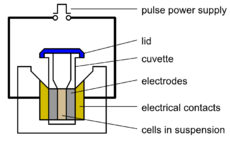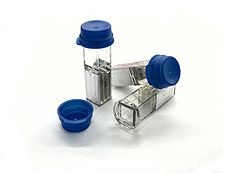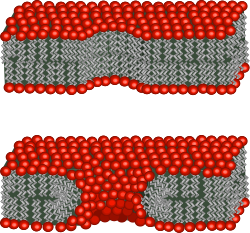
Electroporation
Encyclopedia

Cell membrane
The cell membrane or plasma membrane is a biological membrane that separates the interior of all cells from the outside environment. The cell membrane is selectively permeable to ions and organic molecules and controls the movement of substances in and out of cells. It basically protects the cell...
caused by an externally applied electrical field. It is usually used in molecular biology
Molecular biology
Molecular biology is the branch of biology that deals with the molecular basis of biological activity. This field overlaps with other areas of biology and chemistry, particularly genetics and biochemistry...
as a way of introducing some substance into a cell
Electrochemotherapy
Electrochemotherapy is a therapeutic approach providing delivery into cell interior of non-permeant drugs with intracellular targets. It is based on the local application of short and intense electric pulses that transiently permeabilize cell membrane, thus allowing transport of molecules otherwise...
, such as loading it with a molecular probe, a drug that can change the cell's function, or a piece of coding DNA
DNA
Deoxyribonucleic acid is a nucleic acid that contains the genetic instructions used in the development and functioning of all known living organisms . The DNA segments that carry this genetic information are called genes, but other DNA sequences have structural purposes, or are involved in...
.
Electroporation is a dynamic phenomenon that depends on the local transmembrane voltage at each point on the cell membrane. It is generally accepted that for a given pulse duration and shape, a specific transmembrane voltage threshold exists for the manifestation of the electroporation phenomenon (from 0.5 V to 1 V). This leads to the definition of an electric field magnitude threshold for electroporation (Eth). That is, only the cells within areas where E≧Eth are electroporated. If a second threshold (Eir) is reached or surpassed, electroporation will compromise the viability of the cells, i.e., irreversible electroporation.
In molecular biology, the process of electroporation is often used for the transformation
Transformation (genetics)
In molecular biology transformation is the genetic alteration of a cell resulting from the direct uptake, incorporation and expression of exogenous genetic material from its surroundings and taken up through the cell membrane. Transformation occurs naturally in some species of bacteria, but it can...
of bacteria, yeast
Yeast
Yeasts are eukaryotic micro-organisms classified in the kingdom Fungi, with 1,500 species currently described estimated to be only 1% of all fungal species. Most reproduce asexually by mitosis, and many do so by an asymmetric division process called budding...
, and plant
Plant
Plants are living organisms belonging to the kingdom Plantae. Precise definitions of the kingdom vary, but as the term is used here, plants include familiar organisms such as trees, flowers, herbs, bushes, grasses, vines, ferns, mosses, and green algae. The group is also called green plants or...
protoplast
Protoplast
Protoplast, from the ancient Greek πρῶτον + verb πλάθω or πλάττω , initially referred to the first organized body of a species.Protoplast has several biological definitions:...
s. In addition to the lipid membranes, bacteria also have cell wall
Cell wall
The cell wall is the tough, usually flexible but sometimes fairly rigid layer that surrounds some types of cells. It is located outside the cell membrane and provides these cells with structural support and protection, and also acts as a filtering mechanism. A major function of the cell wall is to...
s which are different from the lipid membranes and are made of peptidoglycan
Peptidoglycan
Peptidoglycan, also known as murein, is a polymer consisting of sugars and amino acids that forms a mesh-like layer outside the plasma membrane of bacteria , forming the cell wall. The sugar component consists of alternating residues of β- linked N-acetylglucosamine and N-acetylmuramic acid...
and its derivatives. However, the walls are naturally porous and only act as stiff shells that protect bacteria from severe environmental impacts. If bacteria and plasmid
Plasmid
In microbiology and genetics, a plasmid is a DNA molecule that is separate from, and can replicate independently of, the chromosomal DNA. They are double-stranded and, in many cases, circular...
s are mixed together, the plasmids can be transferred into the cell
Cell (biology)
The cell is the basic structural and functional unit of all known living organisms. It is the smallest unit of life that is classified as a living thing, and is often called the building block of life. The Alberts text discusses how the "cellular building blocks" move to shape developing embryos....
after electroporation. Several hundred volt
Volt
The volt is the SI derived unit for electric potential, electric potential difference, and electromotive force. The volt is named in honor of the Italian physicist Alessandro Volta , who invented the voltaic pile, possibly the first chemical battery.- Definition :A single volt is defined as the...
s across a distance of several millimeters are typically used in this process. Afterwards, the cells have to be handled carefully until they have had a chance to divide producing new cells that contain reproduced plasmids. This process is approximately ten times as effective as chemical transformation.
This procedure is also highly efficient for the introduction of foreign gene
Gene
A gene is a molecular unit of heredity of a living organism. It is a name given to some stretches of DNA and RNA that code for a type of protein or for an RNA chain that has a function in the organism. Living beings depend on genes, as they specify all proteins and functional RNA chains...
s in tissue culture cells, especially mammal
Mammal
Mammals are members of a class of air-breathing vertebrate animals characterised by the possession of endothermy, hair, three middle ear bones, and mammary glands functional in mothers with young...
ian cells. For example, it is used in the process of producing knockout mice, as well as in tumor treatment, gene therapy, and cell-based therapy. The process of introducing foreign DNAs into eukaryotic cells is known as transfection
Transfection
Transfection is the process of deliberately introducing nucleic acids into cells. The term is used notably for non-viral methods in eukaryotic cells...
.
Laboratory Practice

Suspension (chemistry)
In chemistry, a suspension is a heterogeneous fluid containing solid particles that are sufficiently large for sedimentation. Usually they must be larger than 1 micrometer. The internal phase is dispersed throughout the external phase through mechanical agitation, with the use of certain...
is pipette
Pipette
A pipette is a laboratory tool used to transport a measured volume of liquid.-Use and variations:Pipettes are commonly used in molecular biology, analytical chemistry as well as medical tests...
d into a glass or plastic cuvette which has two aluminum electrode
Electrode
An electrode is an electrical conductor used to make contact with a nonmetallic part of a circuit...
s on its sides.
For bacterial electroporation, typically a suspension of around 50 microliters is used. Prior to electroporation it is mixed with the plasmid
Plasmid
In microbiology and genetics, a plasmid is a DNA molecule that is separate from, and can replicate independently of, the chromosomal DNA. They are double-stranded and, in many cases, circular...
to be transformed. The mixture is pipetted into the cuvette, the voltage and capacitance are set, and the cuvette is inserted into the electroporator. Immediately after electroporation, one milliliter of liquid medium is added to the bacteria (in the cuvette or in an eppendorf tube), and the tube is incubated at the bacteria's optimal temperature
Temperature
Temperature is a physical property of matter that quantitatively expresses the common notions of hot and cold. Objects of low temperature are cold, while various degrees of higher temperatures are referred to as warm or hot...
for an hour or more to allow recovery of the cells and expression of antibiotic
Antibiotic
An antibacterial is a compound or substance that kills or slows down the growth of bacteria.The term is often used synonymously with the term antibiotic; today, however, with increased knowledge of the causative agents of various infectious diseases, antibiotic has come to denote a broader range of...
resistance, followed by spreading on agar
Agar
Agar or agar-agar is a gelatinous substance derived from a polysaccharide that accumulates in the cell walls of agarophyte red algae. Throughout history into modern times, agar has been chiefly used as an ingredient in desserts throughout Asia and also as a solid substrate to contain culture medium...
plates.
The success of the elecroporation depends greatly on the purity of the plasmid solution, especially on its salt
Salt
In chemistry, salts are ionic compounds that result from the neutralization reaction of an acid and a base. They are composed of cations and anions so that the product is electrically neutral...
content. Solutions with high salt concentrations might cause an electrical discharge (known as arc
Electric arc
An electric arc is an electrical breakdown of a gas which produces an ongoing plasma discharge, resulting from a current flowing through normally nonconductive media such as air. A synonym is arc discharge. An arc discharge is characterized by a lower voltage than a glow discharge, and relies on...
ing), which often reduces the viability of the bacteria.
For a further detailed investigation of the process more attention should be paid to the output impedance
Output impedance
The output impedance, source impedance, or internal impedance of an electronic device is the opposition exhibited by its output terminals to an alternating current of a particular frequency as a result of resistance, inductance and capacitance...
of the porator device and the input impedance
Input impedance
The input impedance of an electrical network is the equivalent impedance "seen" by a power source connected to that network. If the source provides known voltage and current, such impedance can be calculated using Ohm's Law...
of the cells suspension (e.g. salt
Salt
In chemistry, salts are ionic compounds that result from the neutralization reaction of an acid and a base. They are composed of cations and anions so that the product is electrically neutral...
content). As the process needs direct electrical contact between the electrodes and the suspension, and is inoperable with isolated electrodes, obviously the process involves certain electrolytic
Electrolysis
In chemistry and manufacturing, electrolysis is a method of using a direct electric current to drive an otherwise non-spontaneous chemical reaction...
effects, due to small currents and not only fields.
Electroporators
Electroporators come in two types: hand-held and bench-tops. Benchtop electroporators are generally used as common lab equipment, residing atop a central bench or hood. They offer the advantage of electroporating multiple samples at the same time. They can also be set to different operating parameters depending on whether or not the cell has a cell wall. In contrast, handheld electroporators are cordless, rechargeable and use disposable pipectrodes, which combine elements of both cuvettes and pipettes. Their operating parameters are preset to the optimal parameters for transforming either bacteria or mammalian cells.Both types of electoporators have been used on a wide range of cells - including E. coli (for transformation) and mammalian cells such as neurons, astrocytes, neuroglia, lymphocytes, monocytes, fibroblasts, epithelial and endothelial cells from humans, mice, rats and monkeys (for transfection).
Medical Applications
A higher voltageVoltage
Voltage, otherwise known as electrical potential difference or electric tension is the difference in electric potential between two points — or the difference in electric potential energy per unit charge between two points...
of electroporation was found in pigs to irreversibly destroy target cells within a narrow range while leaving neighboring cells unaffected, and thus represents a promising new treatment for cancer, heart disease and other disease states that require removal of tissue.
Electroporation can also be used to help deliver drugs or genes into the cell by applying short and intense electric pulses that transiently permeabilize cell membrane, thus allowing transport of molecules otherwise not transported through a cellular membrane. This procedure is referred to as electrochemotherapy
Electrochemotherapy
Electrochemotherapy is a therapeutic approach providing delivery into cell interior of non-permeant drugs with intracellular targets. It is based on the local application of short and intense electric pulses that transiently permeabilize cell membrane, thus allowing transport of molecules otherwise...
when the molecules to be transported is a chemotherapeutic agent or gene electrotransfer
Gene electrotransfer
Gene electrotransfer is a versatile biotechnology technique that enables transfer of genetic material into prokaryotic or eukaryotic cells. It is based on a physical method named electroporation, where transient increase in the permeability of cell membrane is achieved when submitted to short and...
when the molecule to be transported is DNA.
Physical Mechanism
Electroporation allows cellular introduction of large highly charged molecules such as DNADNA
Deoxyribonucleic acid is a nucleic acid that contains the genetic instructions used in the development and functioning of all known living organisms . The DNA segments that carry this genetic information are called genes, but other DNA sequences have structural purposes, or are involved in...
which would never passively diffuse across the hydrophobic bilayer
Lipid bilayer
The lipid bilayer is a thin membrane made of two layers of lipid molecules. These membranes are flat sheets that form a continuous barrier around cells. The cell membrane of almost all living organisms and many viruses are made of a lipid bilayer, as are the membranes surrounding the cell nucleus...
core. This phenomenon indicates that the mechanism is the creation of nm-scale water-filled holes in the membrane. Although electroporation and dielectric breakdown both result from application of an electric field, the mechanisms involved are fundamentally different. In dielectric breakdown the barrier material is ionized, creating a conductive pathway. The material alteration is thus chemical in nature. In contrast, during electroporation the lipid molecules are not chemically altered but simply shift position, opening up a pore which acts as the conductive pathway through the bilayer as it is filled with water.

Capacitor
A capacitor is a passive two-terminal electrical component used to store energy in an electric field. The forms of practical capacitors vary widely, but all contain at least two electrical conductors separated by a dielectric ; for example, one common construction consists of metal foils separated...
through the migration of ions from the surrounding solution. Once the critical field is achieved there is a rapid localized rearrangement in lipid morphology. The resulting structure is believed to be a “pre-pore” since it is not electrically conductive but leads rapidly to the creation of a conductive pore. Evidence for the existence of such pre-pores comes mostly from the “flickering” of pores, which suggests a transition between conductive and insulating states. It has been suggested that these pre-pores are small (~3 Å) hydrophobic defects. If this theory is correct, then the transition to a conductive state could be explained by a rearrangement at the pore edge, in which the lipid heads fold over to create a hydrophilic interface. Finally, these conductive pores can either heal, resealing the bilayer or expand, eventually rupturing it. The resultant fate depends on whether the critical defect size was exceeded which in turn depends on the applied field, local mechanical stress and bilayer edge energy.

